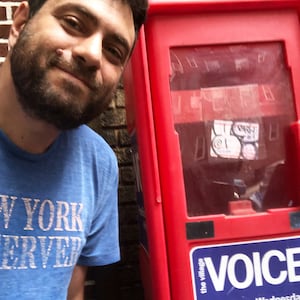Are alt-weeklies ever going to catch a break? An already precarious media industry has only become more precarious for alternative weeklies, which are mainly funded by ads from restaurants, bars, and concert venues—businesses that depend on people gathering in large groups, and whose cultural coverage centers around telling readers to go out and do things.
It’s a story we’ve all heard before. Many alternative weeklies have been gutted, or closed in the last five years. The Village Voice closed in 2018; LA Weekly was sold in 2017 and gutted; the same year Baltimore City Paper closed. Others were casualties of the pandemic: City Pages, Minnesota’s beloved alt-weekly, particularly known for music writing, closed last fall.
The pandemic was supposed to be the “total annihilation” of alt-weeklies. But after we moved on from the doom-and-gloom headlines, many papers continued to do backbreaking work, holding power structures accountable as they continued to cover the pandemic with shrunken newsrooms, supporting creative communities, and holding power structures accountable in the voicey, fearless way that only alt-weeklies can.
Despite a loss of revenue, their reporting was more necessary than ever. Many spent weeks covering Black Lives Matter protests, like INDY Week, Austin Chronicle, Pittsburgh City Paper, the Portland Mercury and Willamette Week, Portland, Oregon’s Pulitzer Prize-winning alt-weekly, which saw both its web traffic and its Friends of Willamette Week membership program grow exponentially in 2020 (and where this writer previously worked and still occasionally freelances). Reader donations have been a “lifesaver,” said editor and publisher Mark Zusman. “I’m hitting my head with a hammer saying, ‘Why didn’t I start this sooner?’”
Others found new ways to survive. Boston Dig stopped publishing in March 2020, but started up again in June. The Chicago Reader is in the process of becoming a nonprofit, but survived 2020 by moving to biweekly printing and ramping up merchandising projects. They created a coloring book, made one of their covers into a puzzle, started a book club, and compiled a cookbook with recipes from Chicago chefs and bartenders.
While so much news coverage of alt-weeklies has eulogized them before they’re gone, perhaps the real story is one of resilience. Because for all the stories about the end of alt-weeklies, there are many that, against all odds, have survived. In true alt-weekly edge, it’s a stubborn, punk refusal to let go. Here are four of their stories.
When the pandemic hit, it might have been easier to shut down the Cleveland Scene. Before the coronavirus, the Scene had five editorial staffers and was putting out a paper once a week, plus hosting events, like a beer festival in a park or a brunch. When the pandemic hit, all event revenue was gone, as well ad revenue from restaurants, bars, and venues. The paper stopped printing from March to July and three people were laid off.
“I think there was probably a very real sense among the ownership group that it might be easier and the best decision, to just shut it all down,” Grzegorek said. “Thankfully, that didn’t happen.”
In addition to getting a PPP loan, the paper started the Scene Press Club, where they solicited donations from readers in exchange for swag like branded water bottles and car magnets, something many alt-weeklies have done since last March. On the donation page, they quantified for readers exactly what different amounts would mean for saving the paper: a $15-50 one-time donation covers the cost of three reporters’ notebooks or filing a public records request; a $40-per-month donation underwrites a cover illustration for one of a Best of Cleveland issue.
“We threw up the bat signal and said, ‘Oh my God, we’re done unless you help us,’” Grzegorek said. And it worked.
“[Readers] shocked us, just with the amount and energy with which they supported us,” he said. “In the midst of everything going on, that people still found a way to help us out and make sure we survived is an indescribable feeling.” It was those donations, he said, that “gave us a way forward.”
The Scene brought back the print paper on July 1, the week of its 50th anniversary. It now prints every other week. They were also able to hire the food editor back. Right now, the editorial staff is Grzegorek, a senior writer, a food editor, the publisher, and one salesperson, but Grzegorek is hopeful they’ll be able to bring back more staff. Cleveland Scene is part of Euclid Media Group, which owns seven alt-weeklies, all of which share a production staff.
Grzegorek said he believes people have become more vocal about their appreciation for the Scene and are more tuned in to the struggles of the media industry than ever before.
“I think more so than in years past, people are very cognizant of the staffing struggles of the industry as a whole,” he said. “I have seen people being more vocal about it, shouting out and recognizing stories that otherwise wouldn’t have gotten told or perspectives that alt-weeklies have traditionally continued to bring to the stories that shape their cities.”
Even with just three editorial staffers, the Scene was able to tackle big stories, including a longform investigation about discrimination at Cleveland’s health department, as well as an in-depth essay about the fraught history between the city’s police union and Black Lives Matter, and a longform investigation of an Instagram whisper network about sexual assaults at Case Western University, which Grzegorek said is something no other outlet was looking into.
“Every time one closes, especially the stature of The [Village] Voice or in Baltimore, there's inevitably some essay about alt-weeklies being done and I don’t think that’s ever really been true or even approaching true,” he said. “Every city needs more journalists, all the time.”
Seven Days isn’t a traditional alt-weekly: It has the largest print circulation in Vermont and one of the largest newsrooms in the state, making it more of a “hybrid community weekly,” said Paula Routly, the paper’s co-owner, publisher, and co-editor who, along with Pamela Polston, founded the publication in 1995.
“I think I realized right away, like pouring with sweat, that we couldn’t stop publishing or we’d be dead in the water,” said Routly of how Seven Days adapted to the deadly pandemic. “This is what we do: We’re a source of information. If we can’t produce that in this time when people want the information so badly, we can forget about it; it’s over.”
Based in Burlington, Seven Days distributes two hours in every direction to cater to the rural nature of the state—much of which has a broadband issue—even if it means dropping off five papers somewhere sparsely populated. When restaurants and businesses closed last March, readers volunteered to put newspaper boxes directly on their lawns, so neighbors could more easily pick up papers.
Seven Days hasn’t cut circulation or even gotten much smaller than 80 pages—a typical issue is 100-plus pages, large for an alt-weekly. They were able to bring back the seven staff they laid off after six weeks. (One decided not to come back and one sales position was eliminated.)
The paper had to stop hosting events and printing several of their guides, but they reached out to businesses like the Department of Health, a local hospital, and banks to find new advertisers. They pitched new guides, including a travel guide for the Vermont Department of Tourism, encouraging safe travel in the state. They were also able to keep revenue-generators like monthly parenting and real-estate inserts.
“Alt-weeklies tend to be scrappy,” said Cathy Resmer, deputy publisher and co-owner. “We’re entrepreneurial. It’s true of almost any alt-weekly. They have had to struggle to survive and try to figure out, ‘where is the space where I can be?’ So they’re accustomed to seeking and finding those opportunities quickly.”
And partially because of the state’s broadband problem, Seven Days receives a revenue source that’s long dried up for many alt-weeklies: classified ads. The section is typically 10-20 pages of job ads, real estate, line listings, and legal notices. While they received fewer classifieds during the pandemic, they’re starting to come back. “It means that people are planning,” said Routly. “That's the first sign of life.”
Seven Days is often pointed to as a successful alternative weekly for being a profitable print paper in an industry in crisis. During the Recession, when newsrooms were cutting staff, Seven Days was hiring more journalists. As many newsrooms have shrunk, they’ve grown substantially over the last decade; they’re even hiring now. While many alt-weeklies have been sold to parent companies, Seven Days isn’t only still run by the people who started it, it’s partially employee-owned. At the end of 2019, the company made 13 co-owners of staffers from its reporting, editing, sales, and production teams.
“Because we have local owners and our owners are journalists, it’s always been important for us to put out high-quality journalism, so we haven’t let that suffer,” said Resmer. “We’ve cut in all kinds of ways, but we haven’t cut our core product, and I think people are grateful for that.”
They’re also one of the only news organizations in the state doing longform journalism. Last year, they won an Edward R. Murrow award for a collaboration with Vermont Public Radio on the state's eldercare facilities. During the pandemic they did a “quaranzine,” where local artists reflected on how life has changed, created a takeout website for restaurants in Vermont, and published a cover story about an outbreak at a nursing home, among other long-form investigations and daily news.
Like other alt-weeklies, Seven Days has had success asking readers for donations, increasing the amount raised in 2020 tenfold. The success may be partly fueled by Routly starting to write publisher’s notes to readers, where she addresses them on a personal level, like telling them about the PPP loan and her mother’s death.
They’ve also had advertisers who took out large ads specifically because they wanted to support Seven Days, like Ben and Jerry’s and a few car dealerships, who ran large ads with quotes about supporting journalism. Routly attributes much of the success of the paper to the identifiable community.
“There is a real community here,” said Routly, “and a real sense of interdependence.”
Last summer, reporters in the The Stranger office could feel the tear-gas through the windows. Their office was directly at the site of the Capitol Hill Autonomous Zone, the multi-week occupation of the area directly surrounding Seattle Police Department’s East Precinct building, which the paper covered for weeks in the summer of 2020.
“It became so clear how necessary our type of coverage was,” said editor Chase Burns. “For a long time we’d wondered what our purpose was, especially in a landscape that was dwindling in terms of media. Around June, we were like, ‘the work we do is so important.’ We felt really valuable to our city.”
The Stranger is owned by Index Newspapers, which also owns the Portland Mercury. Both papers had been printing every other week, but stopped printing when the pandemic hit. The Mercury had major layoffs, and The Stranger laid off 18 people, essentially cutting it in half—at the same time they were getting a flood of attention and readership from readers hungry for coronavirus news.
Like other alt-weeklies, The Stranger started asking readers for contributions last year, something they were long against, but readers donated more than they expected. The amateur porn Hump! Film Festival has long been a big revenue generator for the paper and doing it virtually was surprisingly successful, with more people interested in participating than usual. By moving the film festival online, they were able to scale it up and save money on renting venues. “Those two things are how we survived,” Burns said.
Burns says the print paper could come back eventually, but it’s not on the table right now, making the paper, essentially, a blog, albeit a high-traffic one. “We're not thinking we're going to disappear tomorrow or even next year, which is a big improvement from where we were a year ago,” he said.
Burns says The Stranger’s coverage on protests and the pandemic has given it an opportunity to redefine its relationship with the city. It's a relationship that’s traditionally been antagonistic, which Burns believes was reflective of a culture of the ‘90s and early 2000s, the heyday of alt-weeklies.
“I think the generations have shifted a little bit and the question of ‘how do younger millennials direct an alt-weekly?’ is a question I think about a lot, because it’s not actually of our time,” said Burns, who is 28. “The question I have to wrestle with is: what is our purpose in 2021, in a world where Twitter exists, in a world where maybe we don’t have a newspaper, in a world where news has become increasingly nationalized. What do we do as people who have inherited the legacy of an alternative newspaper and how do we serve the city?”
When the South by Southwest (SXSW) festival was cancelled in early March 2020, it was one of the first wake-up calls that the coronavirus was about to have impacts that lasted much longer than two-week office closures.
“The creative sector has been hit really hard across the nation and that’s a big part of Austin’s economy. With South By, the timing couldn’t have been worse,” said publisher Nick Barbaro. “It’s like a second Christmas season for a lot of places and a big advertising boost for the Chronicle.”
While hosting events is a common revenue model for alt-weeklies, there’s no bigger event that’s tied to an alt than SXSW, which had 400,000 attendees in 2019, and has been subsidizing the Chronicle for a few years now. Barbaro characterizes the relationship between the festival and the paper as like a child and an aging parent. The festival grew out of an office downstairs from where the Chronicle was, and was built by Barbaro and Lewis Black, a longtime editor and co-founder of SXSW. “We sort of grew this little thing from nothing and the Chronicle has gotten old and is now the aging parent, and the youngster is taking care of it,” he said.
The paper solicited reader donations and, like the Chicago Reader, put together a city coloring book that raised money for local artists and the Chronicle, as well as pivoted to try to sell ads to places like financial institutions, hospitals and banks, rather than the traditional venue and restaurant advertisers. They got a PPP loan and didn’t have to lay anyone off, though a couple of staff left, whose positions they did not fill.
“We had some good years in the ’90s,” Barbaro said, mentioning that the Chronicle owns the property their office is on. “There was some cushion there. We could afford to absorb losses.”
He’s hoping many businesses can come back, but is also curious to see what arrives in the place of what’s been lost. And what that means for the alt-weeklies who are essential to energizing the creative culture of their communities, in a way no other type of media does.
Barbaro said his favorite quote of the year in the Chronicle came from a food story about a beloved vegetarian restaurant going out of business, where the eatery’s owner said, “This thing has been like a forest fire. It’s killed a lot of things, but after a forest fire, stuff grows back, and you’ll see a lot of new greenery grow up, but it won’t be the same stuff that’s there before.”
“There’s gonna be a whole new generation of stuff,” said Barbaro. “Our job is to stay on top of that new generation of music clubs that haven’t been there before.”



